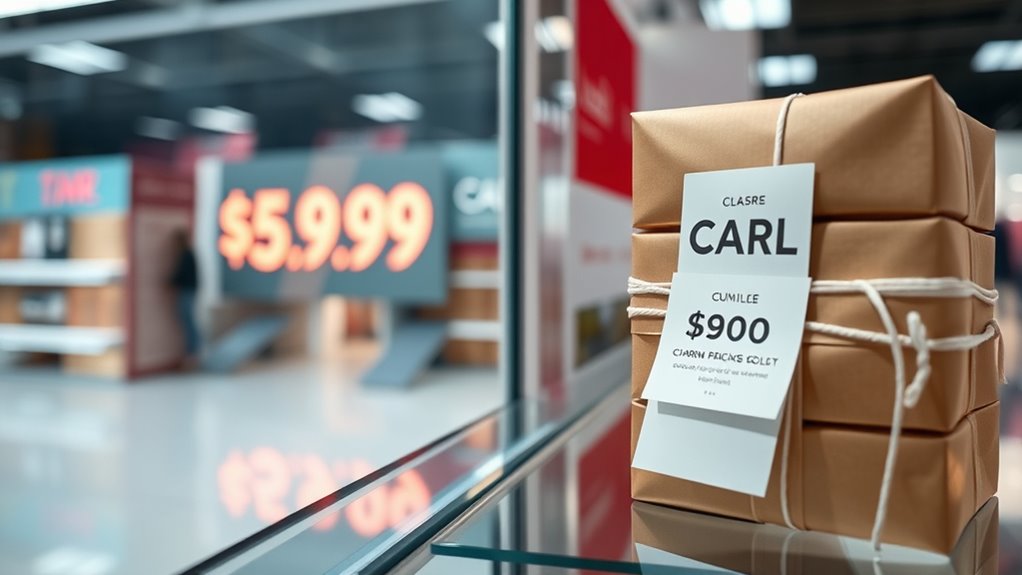Psychological pricing tricks like charm pricing and bundling influence how you perceive value and make buying decisions. Using prices like $9.99 or $19.95 makes products seem cheaper by triggering subconscious cues and emotional reactions. These tactics tap into your instinct to seek bargains and create urgency, often encouraging you to spend more than you realize. Knowing how these strategies work can help you spot and resist them—if you’re curious, there’s more to uncover behind these clever techniques.
Key Takeaways
- Charm pricing uses prices ending in .99 or .95 to create the perception of a better deal and increase sales.
- Bundling offers discounted packages to boost perceived value and encourage larger purchases.
- Setting prices just below whole numbers leverages subconscious cues, making products seem significantly cheaper.
- Small price differences, like $19.95 vs. $20, trigger feelings of savings and influence buying decisions.
- Retailers craft pricing strategies to evoke emotional responses and subconscious cues that drive consumer behavior.

Have you ever wondered why prices like $9.99 or $19.95 seem so tempting? It’s because those prices tap into your subconscious, shaping your perception of value without you even realizing it. This is the core idea behind psychological pricing tricks—using specific strategies to influence your buying behavior. When you see a product priced just below a whole number, your brain tends to perceive it as markedly cheaper, even if the difference is only a penny or a dime. This subtle cue makes you more likely to make a purchase, believing you’re getting a better deal. Retailers know this and craft their prices to maximize appeal, often setting them just under a round number to trigger that perception of savings. Your buying behavior is often driven by these cues, even if you think you’re making purely rational decisions.
This tactic operates because your brain tends to focus on the first digit of a price rather than the last. When you see $9.99, your mind registers it as closer to $9 rather than $10, which feels more affordable. It’s a classic example of how price perception influences your decision-making process. By creating a small psychological gap, businesses encourage you to see the product as a bargain, nudging you toward buying it. This isn’t just about saving a few cents; it’s about how your mind interprets the value of what’s offered. When prices are set this way, your perceived savings feel substantial enough to sway your buying behavior, even if the actual difference is minimal.
Additionally, such pricing strategies play on your emotional responses. You might associate prices ending in .99 with discounts, deals, or clearance sales, which often trigger a sense of urgency or excitement. These tactics make you feel like you’re getting more for your money, which can override rational considerations like comparing prices or evaluating quality. Retailers understand that your perception of value greatly influences your willingness to spend, so they design their prices to tap into those subconscious cues. Recognizing how these beach destinations are marketed can help you understand the subtle ways in which perception influences decision-making.
In the end, your buying behavior is greatly affected by how prices are presented. The small difference between $19.95 and $20, for example, feels substantial because of how your brain perceives value. That’s the power of psychological pricing tricks—they shape your perceptions, influence your emotions, and ultimately guide your purchasing decisions, often without you realizing it. By understanding these tactics, you can become more aware of how pricing influences you and make more deliberate purchasing choices.
Frequently Asked Questions
How Do Psychological Pricing Tactics Influence Consumer Trust?
Psychological pricing tactics can boost your consumer perception and enhance pricing credibility when used thoughtfully. By presenting prices that seem more appealing, like $9.99 instead of $10, you make your offerings feel more affordable, building trust. However, if overused or seen as manipulative, these tactics can backfire, damaging consumer trust. To succeed, focus on transparency and consistency, ensuring your pricing strategies genuinely reflect value.
Are There Legal Restrictions on Certain Pricing Strategies?
You might think all pricing tricks are fair game, but actually, there are legal restrictions to guarantee pricing transparency and regulatory compliance. Some tactics, like deceptive discounts or hidden fees, cross the line into misleading consumers. These laws protect you from unfair practices, making sure businesses clearly communicate prices. So, while clever tricks can tempt, keep in mind that rules exist to prevent shady tactics and maintain honest market standards.
Do Pricing Tricks Work Equally Across Different Cultures?
Pricing tricks don’t work equally across different cultures because cultural perceptions and pricing norms vary markedly. You might find charm pricing effective in one country where ending prices with .99 feels appealing, but less so elsewhere. Understanding local customs helps you tailor strategies, ensuring they resonate with your audience. So, always research cultural perceptions before applying psychological pricing tricks, as what works in one region may not in another.
How Can Small Businesses Effectively Implement These Strategies?
Think of your pricing strategy as a magnet—drawing in customers through clever cues. You can effectively implement these strategies by understanding how price perception influences consumer behavior. Use charm pricing, like ending prices with .99, to evoke a sense of value. Bundle products to create perceived savings, encouraging larger purchases. Keep testing and observing customer responses, tweaking your approach to match your audience’s preferences and make your offers irresistible.
What Are the Psychological Effects of Price Anchoring?
Price anchoring influences your perception of value by setting a reference point that impacts your buying decision. When you see a high initial price, you’re likely to perceive subsequent prices as more reasonable, leveraging cognitive bias. This psychological effect makes you feel like you’re getting a better deal, increasing the likelihood of purchase. As a small business, using price anchoring can enhance perceived value and encourage customers to choose your products over competitors.
Conclusion
Now that you know these psychological pricing tricks, you can spot charm pricing, bundling, and more at a glance. It’s like seeing through a magician’s illusion—suddenly, prices aren’t just numbers; they’re clever tactics designed to influence your choices. So, next time you shop, remember: what seems like a deal might just be a well-crafted trick. Stay aware, stay savvy, and enjoy getting the best value without falling for the illusion.









